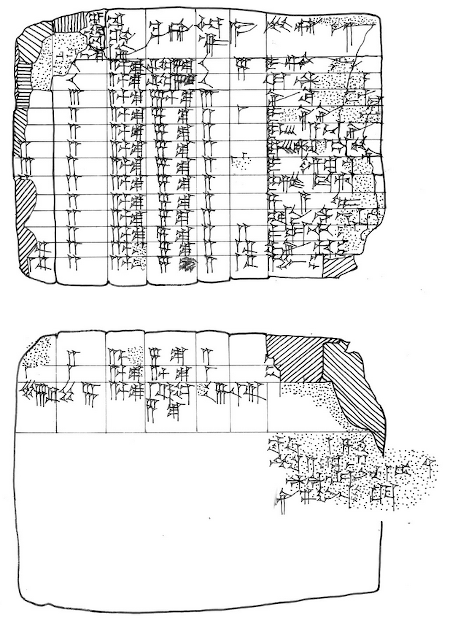2024-12-21 17:25:00
www.datafix.com.au

For a full list of BASHing data blog posts see the index page. ![]()
I knew that data tables had been around a long time, but I didn’t appreciate how long until I read recently about account-keeping in ancient Mesopotamia.
The accounts were written on clay tablets, sometimes with impressed lines to mark off rows and columns. Here’s a drawing of the front and back sides of an example:

This tablet was found on the site of the old city of Larsa near the mouth of the Euphrates in Iraq. Someone wrote on the tablet in the Old Babylonian Period, ca 3600-4000 years ago.
The cuneiform text was transliterated and translated by Eleanor Robson, who currently heads the History Department at University College London. You can see her efforts at this website by clicking on the tablet’s British Museum catalog number, BM 085232.
Below I’ve put Prof. Robson’s translation into a spreadsheet. Items in square brackets are guessed fill-ins. The “s.” stands for shekels and “m.” is mūšar, equal to 60 shekels.

It looks to me like a payroll summary from a construction project, but that’s a modern-day view. What’s clear is that the person who inscribed the clay was organising similar data items neatly in rows and columns (with column headers), and operating on those items in ways familiar to us moderns.
Column A, for example, looks like the sum of columns B (or E) and F. Column C is a base rate of pay, and column D is the base rate multiplied by the quantity in column B (or E). Each non-header row corresponds to a person or persons in column G, except the last row with column totals.
This remarkable record is evidence that data tables (as we understand them) were used for record-keeping more than 3500 years ago. It’s tempting to think that civilisation progresses step-wise, and that you could trace the use of data tables in an unbroken path from clay tablets to today’s spreadsheets. I don’t think that’s a realistic view. Inventions get lost or forgotten, then re-invented. What was obvious to that account-keeper in ancient Mesopotamia might not have been obvious at later times and in other places.
I’m pretty confident, though, that in another thousand years there will still be ancient data tables “archived” underground in Iraq, while todays’ billions of spreadsheets in digital form and on non-archival paper will have long since disappeared.
Last update: 2020-08-12
The blog posts on this website are licensed under a
Creative Commons Attribution-NonCommercial 4.0 International License
Keep your files stored safely and securely with the SanDisk 2TB Extreme Portable SSD. With over 69,505 ratings and an impressive 4.6 out of 5 stars, this product has been purchased over 8K+ times in the past month. At only $129.99, this Amazon’s Choice product is a must-have for secure file storage.
Help keep private content private with the included password protection featuring 256-bit AES hardware encryption. Order now for just $129.99 on Amazon!
Support Techcratic
If you find value in Techcratic’s insights and articles, consider supporting us with Bitcoin. Your support helps me, as a solo operator, continue delivering high-quality content while managing all the technical aspects, from server maintenance to blog writing, future updates, and improvements. Support Innovation! Thank you.
Bitcoin Address:
bc1qlszw7elx2qahjwvaryh0tkgg8y68enw30gpvge
Please verify this address before sending funds.
Bitcoin QR Code
Simply scan the QR code below to support Techcratic.

Please read the Privacy and Security Disclaimer on how Techcratic handles your support.
Disclaimer: As an Amazon Associate, Techcratic may earn from qualifying purchases.



















































![YONZEE 2025 Upgrade Sunshade Roof for Tesla Model Y 2020-2024,[No-Gap/Sag-Free] Heat…](https://techcratic.com/wp-content/uploads/2025/05/81U-Kh0bPtL._AC_SL1500_-360x180.jpg)
![for MagSafe Car Mount, [42 Strong Magnet & 360° Rotation] Ultra Magnetic Car Phone…](https://techcratic.com/wp-content/uploads/2025/04/71llbSCVLL._AC_SL1500_-360x180.jpg)



















